Land Invertebrates
Media

Species Types
Scientific Name
Leucauge venusta
Description
The orchard orbweaver is a small, colorful, greenish, delicate spider that makes circular webs in low bushes and damp woodlands. It typically hangs in the middle of its web, its back to the ground.
Media

Species Types
Scientific Name
More than 900 species in North America north of Mexico
Description
Millipedes, which have two pairs of legs per body segment, are harmless detritus-eaters, move slowly, and curl up defensively when harassed.
Media
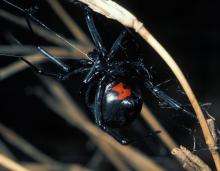
Species Types
Scientific Name
Latrodectus mactans and Latrodectus variolus
Description
The glossy, black-bodied female black widow spider has distinctive red spots on the underside of the abdomen. Only the female can inflict a potentially dangerous bite. The small, seldom-seen male is harmless.
Media
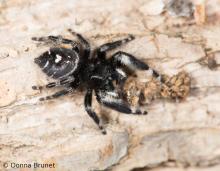
Species Types
Scientific Name
Phidippus audax
Description
The bold jumper, or white-spotted jumping spider, is fuzzy, makes jerky movements, jumps surprisingly long distances, and doesn't build webs. It usually has a black body with white, orange, or reddish spots on the abdomen.
Media

Species Types
Scientific Name
Micrathena spp.
Description
Missouri has three species of spiny orbweavers in genus Micrathena. The webs of these woodland spiders are often run into by hikers!
Media
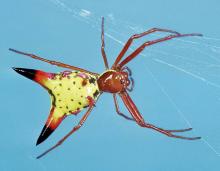
Species Types
Scientific Name
Micrathena sagittata
Description
One of three micrathena spiders in Missouri, the arrowshaped micrathena is small but unforgettable. Females have striking reddish, black, and yellow colors, and a pair of outward-pointing tubercles at the end of the body give it a triangular or "arrow" shape.
Media

Species Types
Scientific Name
About 84 species in North America.
Description
Many blow flies are so shiny and colorful they’re called greenbottles and bluebottles. But pretty as they are, it’s hard not to be repulsed by their larval diets.
Media

Species Types
Scientific Name
About 30 species in North America north of Mexico
Description
Stilt-legged flies are a family of true flies. They are harmless, but most species resemble ichneumon wasps or ants. The middle and back pairs of legs are exceptionally long and thin, while the front pair of legs are much shorter.
Media
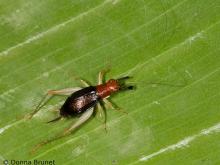
Species Types
Scientific Name
Phyllopalpus pulchellus
Description
The handsome trig lives in vegetation about four feet off the ground near water. This beetle-like cricket may be a mimic of bombardier beetles, which spew foul chemicals for defense.
Media
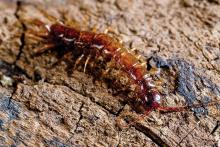
Species Types
Scientific Name
Hundreds of species in North America north of Mexico
Description
Centipedes are familiar to anyone who has overturned rocks and logs, sifted through leaf litter, or dug in the soil. Learn more about Missouri's members of class Chilopoda.
See Also



Media

Species Types
Scientific Name
Cisseps fulvicollis
Description
The yellow-collared scape moth is more often “orange-collared.” And whether you think it looks more like a firefly or a wasp, it’s still a moth!
Media

Species Types
Scientific Name
Nearly 150 species in North America north of Mexico
Description
Slim, delicate plume moths are instantly recognizable by their T-shaped silhouette, long legs, and muted shades of tan and brown. It can be hard to separate the various species.
Media

Species Types
Scientific Name
Pyrrharctia isabella
Description
Not many people know the adult Isabella tiger moth when they see one, but we’re all acquainted with its caterpillar, the woolly worm, or woolly bear.
About Land Invertebrates in Missouri
Invertebrates are animals without backbones, including earthworms, slugs, snails, and arthropods. Arthropods—invertebrates with “jointed legs” — are a group of invertebrates that includes crayfish, shrimp, millipedes, centipedes, mites, spiders, and insects. There may be as many as 10 million species of insects alive on earth today, and they probably constitute more than 90 percent all animal species.





















